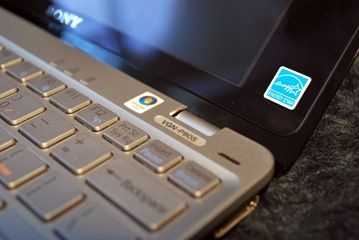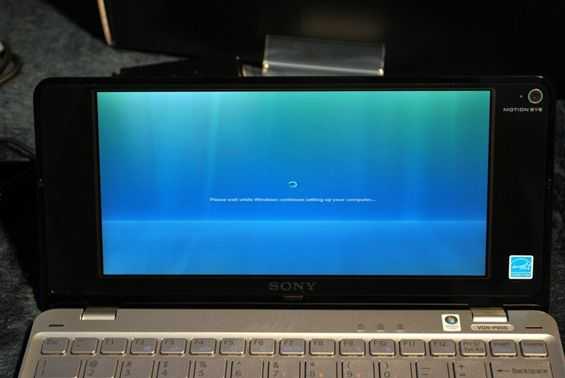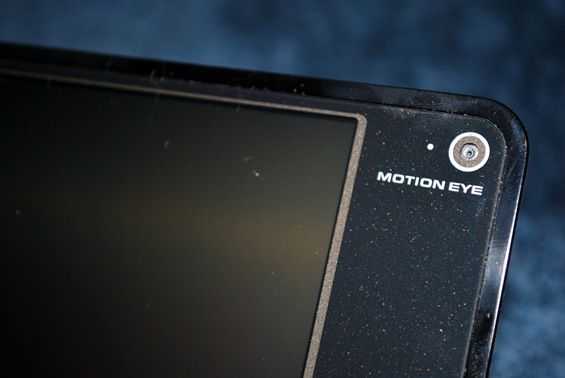Cooling and Noise
 One interesting thing about the VAIO P is that it has an entirely passive cooling system. What does that mean exactly? Well there isn’t a single fan inside the unit. That would make it entirely silent except for the HDD right? Well some VAIO Ps come configured with SSDs which have no moving parts, as is the case with the one I’m reviewing. That means this is just about the most silent computer you could own. It is very hard to tell when the unit is on or off just based on the sound it is making because there is hardly any. The only way hat you’ll hear any noise out of the VAIO P is if you put your ear directly against the single vent. If the unit is on, and you have good hearing, you will be able to hear just the faintest bit of electronic whine. Unless you ear is directly against the unit, it is completely inaudible. If you are someone who hates to hear the fan crankin’ all the time, you’ll be please with the VAIO P’s permanent silent treatment. This will save some power and definitely drop the noise level, but it also means that the unit will get warm. It seems to warm up fairly fast while you use it, but I wouldn’t say that the heat feels any greater than that of an actively cooled computer. Because there is only one vent on the computer I would have to assume that some of the airflow is designed to pass through the keys on the keyboard.
One interesting thing about the VAIO P is that it has an entirely passive cooling system. What does that mean exactly? Well there isn’t a single fan inside the unit. That would make it entirely silent except for the HDD right? Well some VAIO Ps come configured with SSDs which have no moving parts, as is the case with the one I’m reviewing. That means this is just about the most silent computer you could own. It is very hard to tell when the unit is on or off just based on the sound it is making because there is hardly any. The only way hat you’ll hear any noise out of the VAIO P is if you put your ear directly against the single vent. If the unit is on, and you have good hearing, you will be able to hear just the faintest bit of electronic whine. Unless you ear is directly against the unit, it is completely inaudible. If you are someone who hates to hear the fan crankin’ all the time, you’ll be please with the VAIO P’s permanent silent treatment. This will save some power and definitely drop the noise level, but it also means that the unit will get warm. It seems to warm up fairly fast while you use it, but I wouldn’t say that the heat feels any greater than that of an actively cooled computer. Because there is only one vent on the computer I would have to assume that some of the airflow is designed to pass through the keys on the keyboard.
Screen
The screen on the VAIO P is unusual in the world of mobile computers. It uses a very uncommon resolution which leaves it with an non-standard aspect ratio. Most netbooks out there today use a common resolution of 1024×600 which translates to a 1.67:1 aspect ratio (which isn’t actually a standard by itself, but it is commonly used) and 384,000 pixels. The VAIO P on the other hand has an immensely wide 1600×768 resolution display (with an 8 inch diagonal) which is 2.08:1 aspect ratio at 1,228,800 pixels. That’s 3.2x more screen real estate than a 1024×600 display which is pretty impressive. Though that extra space comes at a price when crammed into an 8 inch diagonal. The higher pixel density means that things can be difficult to see unless you are close to the screen or you have very good eye sight. Turning up the DPI can help counteract the high pixel density, more on that in the long term software impressions section of the VAIO P review.
The screen’s bezel is entirely behind the protective screen cover, be it glass or plastic (it feels like plastic), very similar to the screens of the HP Mini 1000 and upcoming Samsung N310 [Portal page]. Built into the right side of the screen, in the bezel, is a 1.3MP Motion Eye, as Sony likes to call all of their built in webcams. The VAIO P’s lid is extremely thin. About as thin as an iPod Touch (if that gives you any reference). It is also very light weight and has a low hinge strength, making it easy to move. I mentioned that I really liked the hinge strength level on the VAIO P, but I know it isn’t for everyone. If it was any less strong, it would move around too easily; I hope that it doesn’t degrade in strength over time.
The width of the screen was somewhat designated by the idea that Sony didn’t want people to ever have to scroll horizontally while browsing the web. With 1600 pixels, I think it would be very rare that you will ever need to. Another factor that determined the odd aspect ratio of the screen is its relationship to the keyboard.
(continue reading on page 4…)













New article: Long term hardware impressions – Sony VAIO P http://cli.gs/emb5T7
Tried this device recently. very slim but lcd vviewing angles and colors are poor. Overall ergonomics in use very bad with the mouse pointer.
I tried one too briefing in a store and I thought the lcd viewing angle was bad too
Cheers for all the work which clearly has gone into producing the review for us all.
Thanks Toby : )
How does the Vaio compare with the Fujitsu U2010?
Thanks for the review!
Ben,
Before wrapping up, I was hoping you would comment on the G3 radio: I still havn’t heard whether it works in Europe [Hey, for a lot of people this will be a Mobile Internet Device!]. I remember someone tried to open the SIM slot with pliers, but to no avail.
Sorry DoctorZick, I’m based in the US, and my Japanese VAIO P doesn’t have the built in 3G radio.
Hey Ben,
I could use your help/advice. I recently performed a ‘clean install’ of WIndows 7 on my SONY VAIO pc, and I think I may have deleted the AlpsPoint software that came with it. Now, I have lost the scroll fnction on my touchpad, and I would like it back.
Where/how can I reinstall the AlpsPoint software?
Thanks